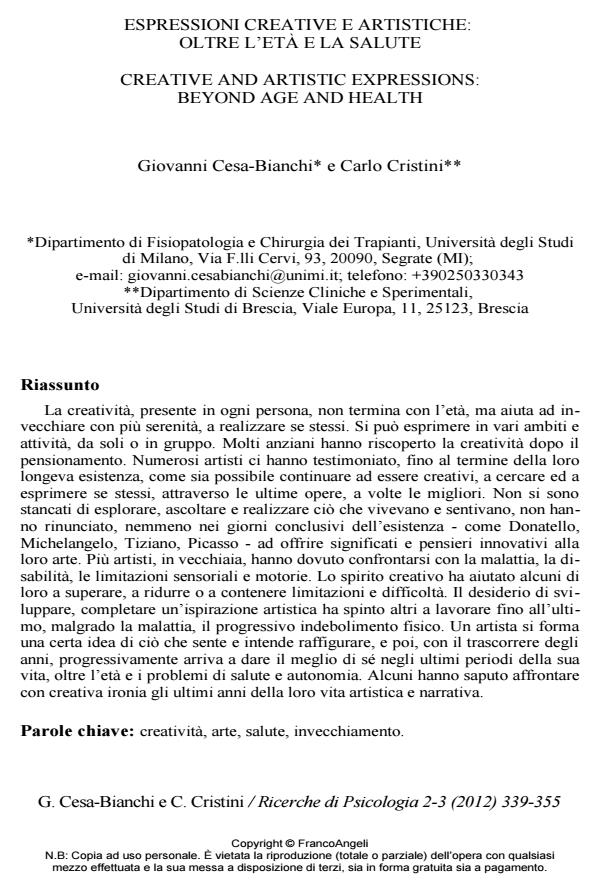Creative and artistic expressions: beyond age and health
Journal title RICERCHE DI PSICOLOGIA
Author/s Giovanni Cesa-Bianchi, Carlo Cristini
Publishing Year 2013 Issue 2012/2-3
Language Italian Pages 17 P. 339-355 File size 236 KB
DOI 10.3280/RIP2012-002013
DOI is like a bar code for intellectual property: to have more infomation
click here
Below, you can see the article first page
If you want to buy this article in PDF format, you can do it, following the instructions to buy download credits

FrancoAngeli is member of Publishers International Linking Association, Inc (PILA), a not-for-profit association which run the CrossRef service enabling links to and from online scholarly content.
Creativity, existing in everyone, doesn’t finish in the old age, but helps to grow old with more serenity, to realize themselves. It can be expressed in a lot of areas and activities, alone or in groups. Many old people have rediscovered creativity after retirement. Many artists have witnessed, until the end of their longlived existence, that’s possible to keep creative along, to seek and express themselves through the latest works, sometimes the best. They haven’t tired to explore, listen and realize what they lived and felt, have not give up, even in the final days of existence - such as Donatello, Michelangelo, Titian and Picasso - to bring meanings and innovative ideas to their art. Several artists, in old age, had to deal with illness, disability, sensory and motor limitations. The creative spirit has helped to overcome some of them, to reduce or contain limitations and difficulties. The motivation to develop and complete artistic inspiration has pushed others to work until the last time, in spite of the disease, the progressive physical weakness. An artist builds an idea of what he feels and intends to represent, and then, with the life-span, gradually he gets to give his best in the last period of his life, beyond the age and health and autonomy problems. Some persons have been able to deal with creative irony the last years of their artistic and story life.
Keywords: Creativity, arts, health, aging.
- Antonini, F.M., & Magnolfi, S. (1991). L’età dei capolavori. Creatività e vecchiaia nelle arti figurative. Venezia: Marsilio
- Bruner, J. (1999). Narratives of aging. Journal of Aging Studies, 13(1), 7-9.
- Bruner, J. (1999). Narratives of aging. Journal of Aging Studies, 13(1), 7-9. Cesa-Bianchi, G., & Cristini, C. (1997). Adattamento, timori, speranze: la qualità della vita in un campione di 100 ultrasessantenni. N.P.S., Rivista della Fondazione “Centro Praxis”, XVII, 4, 557-621
- Cesa-Bianchi, G., & Cristini, C. (1998). Qualità della vita. In M. Cesa-Bianchi & T. Vecchi (Eds.), Elementi di Psicogerontologia (pp.180-196). Milano: FrancoAngeli.
- Cesa-Bianchi, G. (2004). La nuova immagine della vecchiaia. In M. Cesa-Bianchi & O. Albanese (Eds.), Crescere e invecchiare. La prospettiva del ciclo di vita, (pp. 187-193). Milano: Unicopli
- Cesa-Bianchi, G., Porro, A., & Cristini, C. (2012). Processo creativo e longevità. Giornale di Gerontologia, LX, 1, 3-7.
- Cesa-Bianchi, G., Cristini, C., & Cesa-Bianchi, M. (2012). La comunicazione in età senile. In C. Cristini, C. Cipolli, A. Porro & M. Cesa-Bianchi (Eds.), Comunicare con l’anziano, (pp. 25-48). Milano: FrancoAngeli
- Cesa-Bianchi, M. (1998). Giovani per sempre? L’arte di invecchiare. Roma-Bari: Laterza
- Cesa-Bianchi, M. (1999). Cultura e condizione anziana. Vita e Pensiero, Rivista Culturale dell’Università Cattolica del Sacro Cuore, 3, LXXXII, 273-286
- Cesa-Bianchi, M. (2000). Psicologia dell’invecchiamento. Roma: Carocci
- Cesa-Bianchi, M., Cesa-Bianchi, G., & Cristini, C. (2001). Il nonno, il bambino e la città. In C. Stroppa (Ed.), Per una cultura del gioco: come creare una ludoteca (pp. 247-285). Pavia: Italian University Press
- Cesa-Bianchi, M. (2002). Comunicazione, creatività, invecchiamento. Ricerche di Psicologia, XXV, 3, 175-188
- Cesa-Bianchi, M., Cristini, C., & Cesa-Bianchi, G. (2002). L’ultima creatività? In L. Pinkus & A. Filiberti (Eds.), La qualità della morte, (pp. 213-218). Milano: FrancoAngeli
- Cesa-Bianchi, M., & Antonietti, A. (2003). Creatività nella vita e nella scuola. Milano: Mondadori Università.
- Cesa-Bianchi, M. (2006). Lectio. In Laurea honoris causa in Scienze della Comunicazione. Napoli: Università degli Studi Suor Orsola Benincasa
- Cesa-Bianchi, M., & Cristini, C. (2009). Vecchio sarà lei! Muoversi, pensare, comunicare. Napoli: Guida
- Cesa-Bianchi, M., Cristini, C., & Giusti, E. (2009). La creatività scientifica. Il processo che cambia il mondo. Roma: Sovera
- Cesa-Bianchi, M. (2012). Sempre in anticipo sul mio futuro. Auto-biografia […], E. Mancino (Ed.). Napoli: Guida.
- Cristini, C., Cesa-Bianchi, M., Cesa-Bianchi, G., & Porro, A. (2011). L’ultima creatività. Luci nella vecchiaia. Milano: Springer
- Cristini, C., & Cesa-Bianchi, M. (2011). L’ultima creatività fra declino e recupero di sé. In C. Cristini, A. Porro & M. Cesa-Bianchi (Eds.), Le capacità di recupero dell’anziano. Modelli, strumenti e interventi per i professionisti della salute (pp. 486-521). Milano: FrancoAngeli
- Cristini C., Cipolli C., Porro A., & Cesa-Bianchi, M. (Eds.) (2012). Comunicare con l’anziano. Milano: FrancoAngeli
- Cristini, C., Porro, A., & Spano, P.F. (2012). Le botteghe della salute. Rudiano (BS): GAM.
- Demetrio, D. (1996). Raccontarsi. L’Autobiografia come cura di sé. Milano: Raffaello Cortina
- Leone, G. (2002). Autobiografia. Conoscenza di sé e appartenenze sociali. Roma: Carocci
- Madera, M.R., Bellotti, G.G., & Cristini, C. (Eds.) (2011). Psicomotricità. L’intervento integrato con la persona anziana. Varese: Insubria University Press.
- Paolucci, A. (2000). La creatività artistica nella terza età. In Il sapere nella terza età (pp. 21-30). Bologna: Università Primo Levi
- Ploton, L. (2010). Ce que nous enseignent les malades d’Alzheimer. Lyon: Chronique Sociale
- Poli, M.D., & Spada, D. (2007). Musica e neuropsicologia. Punti di incontro. In G. Lucignani & A. Pinotti (Eds.), Immagini della mente. Neuroscienze, arte, filosofia (pp. 231-255). Milano: Cortina
- Shephard, R.J. (1998). Attività fisica, invecchiamento e salute. Milano: McGraw- Hill
- Walter, H. (1999). Vivere la vecchiaia. Sfide e nuove qualità di vita. Roma: Armando.
- Il "pensiero-anziano": verso l'ultima creatività Carlo Cristini, Giovanni Cesa-Bianchi, Marcello Cesa-Bianchi, in RICERCHE DI PSICOLOGIA 4/2015 pp.521
DOI: 10.3280/RIP2014-004001
Giovanni Cesa-Bianchi, Carlo Cristini, Espressioni creative e artistiche: oltre l’età e la salute in "RICERCHE DI PSICOLOGIA " 2-3/2012, pp 339-355, DOI: 10.3280/RIP2012-002013